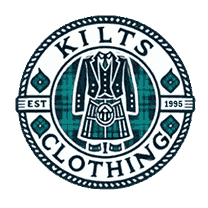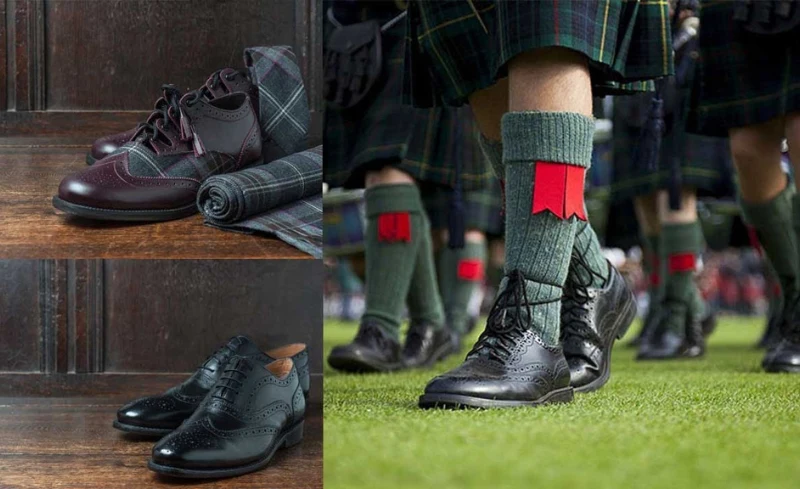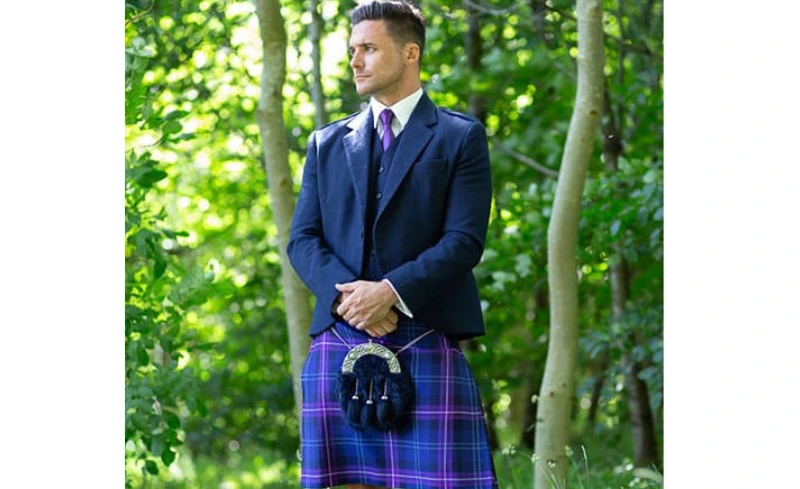Choosing the Right Ghillie Brogues for Your Kilt Outfit

When it comes to traditional Scottish attire, few elements are as iconic as the kilt. However, to complete the look, one must not overlook the importance of the right footwear—specifically, Ghillie Brogues a main part of kilt accessories. These unique shoes are an essential part of the Highland dress, lending authenticity, style, and comfort to your outfit. Whether you are attending a wedding or a formal event or wish to embrace your Scottish heritage, choosing the right Ghillie Brogues is vital. This detailed guide will explore everything you need to know to make the best choice.
What Are Ghillie Brogues?
Ghillie Brogues are traditional Scottish shoes characterized by their unique design part of kilt accessories, which includes a series of long laces that wrap around the ankle and are tied in front. Unlike regular shoes, Ghillie Brogues do not have a tongue, which was historically a practical feature designed to allow the shoes to dry quickly in Scotland’s often wet and boggy conditions. This design also prevents water from collecting inside the shoe, making it ideal for outdoor wear.
The History of Ghillie Brogues
The history of Ghillie Brogues dates back several centuries. Originally, they were worn by Scottish Highlanders as practical footwear suited to the rugged terrain. The lack of a tongue and the extended laces helped keep their feet dry as they traversed moors and marshes. Over time, these shoes evolved from functional footwear to formal wear, now recognized as a quintessential part of the traditional Highland dress.
Key Features to Consider When Choosing Ghillie Brogues
Material
The material of your Ghillie Brogues plays a crucial role in both comfort and durability. Most Ghillie Brogues are made from high-quality leather, which provides a classic look and long-lasting wear. However, not all leathers are the same. When choosing a pair, consider the following:
- Full-grain leather: Known for its durability and natural look, full-grain leather ages beautifully.
- Calfskin leather: Softer and more flexible, calfskin is ideal for those seeking comfort from the first wear.
- Patent leather: Shiny and sleek, patent leather Ghillie Brogues are often chosen for very formal occasions, such as weddings.
Sole Type
The sole of your Ghillie Brogues affects both comfort and grip. Typically, these shoes come with one of the following sole types:
- Leather soles: Traditional and elegant leather soles are preferred for indoor events.
- Rubber soles: Offering better grip and durability, rubber soles are ideal for outdoor events or occasions where slippery surfaces might be encountered.
Lacing and Tassels
The lacing system is a defining feature of Ghillie Brogues. The laces are long and designed to wrap around the ankle before being tied at the front. Some Ghillie Brogues also come with decorative tassels attached to the laces, which can add an extra touch of style. When selecting a pair, ensure that the laces are sturdy and long enough to tie comfortably but not so long that they become cumbersome.
Comfort and Fit
Comfort is paramount, especially if you plan to wear your Ghillie Brogues for extended periods. Here’s what to consider for the best fit:
- Size: Make sure you choose the correct size. Ghillie Brogues should fit snugly but not too tight. Remember that leather shoes can stretch slightly over time.
- Width: Pay attention to the width of the shoe. Some brands offer different width fittings to accommodate various foot shapes.
- Insoles: High-quality insoles can significantly enhance comfort, especially if you plan to be on your feet for hours.
Choosing the Right Ghillie Brogues for Different Occasions
Weddings
For weddings, particularly formal ones, consider Ghillie Brogues made from patent leather or highly polished calfskin. These materials complement the formal nature of the event and match well with a kilt, sporran, and other accessories. Opt for a pair with elegant tassels and ensure the soles are suitable for dancing and extended wear.
Formal Events
If you are attending a formal event such as a dinner or a ball, classic Ghillie Brogues with a leather sole are a perfect choice. These shoes will offer the right balance between tradition and style, ensuring you look sharp while maintaining comfort.
Outdoor Events
When attending outdoor events, especially in Scotland, where the weather can be unpredictable, Ghillie Brogues with rubber soles are advisable. The rubber sole provides better traction, reducing the risk of slipping on wet grass or uneven surfaces. Ensure the leather is treated to withstand the elements, particularly if the event is likely to be damp or muddy.
How to Properly Wear and Care for Your Ghillie Brogues
Wearing Ghillie Brogues
Wearing Ghillie Brogues correctly is essential to complete your kilt outfit. Here are some tips:
- Lacing: Begin by lacing the shoes as you would any other shoe, but instead of tying them at the top, wrap the laces around your ankle two or three times before tying them at the front in a neat bow.
- Sock Placement: The laces should sit comfortably just above the top of your kilt hose (socks). Make sure the laces are neither too tight nor too loose to avoid discomfort.
- Tassels: If your Ghillie Brogues have tassels, position them at the front and ensure they hang evenly.
Caring for Your Ghillie Brogues
Proper care extends the life of your Ghillie Brogues and keeps them looking their best. Follow these care tips:
- Polishing: Regularly polish your Ghillie Brogues with a high-quality shoe polish that matches the color of the leather. This keeps the leather supple and prevents cracking.
- Weatherproofing: Apply a leather conditioner or weatherproofing spray to protect your shoes from moisture, especially if you plan to wear them outdoors.
- Storing: Store your Ghillie Brogues in a cool, dry place. Use shoe trees to maintain their shape and absorb moisture after wear.
Common Mistakes to Avoid When Choosing Ghillie Brogues
Ignoring the Sole Type
One of the most common mistakes is overlooking the sole type. Choosing the wrong sole for the occasion can result in discomfort or even damage to your shoes. Always match the sole type to the event’s setting.
Choosing the Wrong Size
Selecting the wrong size can lead to blisters or discomfort. Remember, leather shoes can stretch slightly, so a snug fit is ideal. However, they should never be too tight.
Skipping Break-In Time
Never wear new Ghillie Brogues straight to an event without breaking them in. Wear them around the house first to ensure they are comfortable and to prevent any issues during the event.
Matching Ghillie Brogues with Your Kilt Accessories
Coordinating Colors
The color of your Ghillie Brogues should complement the rest of your kilt outfit. Black is the most common choice as it pairs well with most tartans and is suitable for formal occasions. However, brown Ghillie Brogues can also work well for less formal events or daytime wear, especially if your kilt has earth tones.
Matching Leather with Accessories
To create a cohesive look, match the leather of your Ghillie Brogues with other leather accessories, such as your sporran and belt. This attention to detail can elevate your overall appearance, making it clear that you’ve thoughtfully curated your outfit.
Considering the Event’s Formality
The level of formality of the event will dictate the style of Ghillie Brogues you should choose. For highly formal events, stick to polished leather with minimal decoration. For more casual gatherings, you have more flexibility to experiment with different styles and finishes.
Conclusion
Choosing the right Ghillie Brogues is essential for completing your traditional kilt accessories with style and authenticity. These unique shoes not only add a touch of heritage to your ensemble but also provide comfort and durability when selected with care.
From understanding the history and key features of Ghillie Brogues to knowing how to wear and care for them properly, every detail contributes to achieving a polished and sophisticated look.Whether you’re dressing for a formal wedding, attending a Highland gathering, or simply embracing your Scottish roots, the right pair of Ghillie Brogues can make all the difference.
By considering factors such as material, sole type, and lacing, and by matching your shoes with the rest of your outfit, you ensure that your Highland dress is both stylish and functional. Avoid common mistakes like ignoring fit or skipping the break-in process to enjoy both comfort and elegance on your special day.
Ghillie Brogues are named after the “ghillie,” a traditional Scottish gamekeeper or guide, reflecting their historical use by Highlanders. The term “brogue” refers to a type of shoe with decorative perforations, which combined with the unique lacing system, makes them distinctively Scottish.
Brogues originally served as practical footwear with perforations for drainage in wet, rugged terrain. Over time, their decorative perforations became a stylistic feature, blending functionality with a distinctive, elegant appearance suitable for both formal and casual settings.
Traditional Scottish shoes are called Ghillie Brogues. These shoes are characterized by their distinctive lacing system and lack of tongue, making them both practical and stylish for Highland dress.
Ghillie Brogues have no tongue to enhance their functionality in rugged Highland terrain. The absence of a tongue helps prevent water from entering the shoe and allows for better drainage, keeping the wearer’s feet dry when traversing moors and marshes. This design also facilitates the lacing system, which wraps around the ankle for added support and stability.
Brogues have holes, or perforations, as a traditional design feature that originally served practical purposes. These holes allowed water to drain out of the shoes in wet conditions, making them more suitable for rugged terrain. Over time, the perforations became a stylish element, contributing to the distinctive and classic look of brogues.





